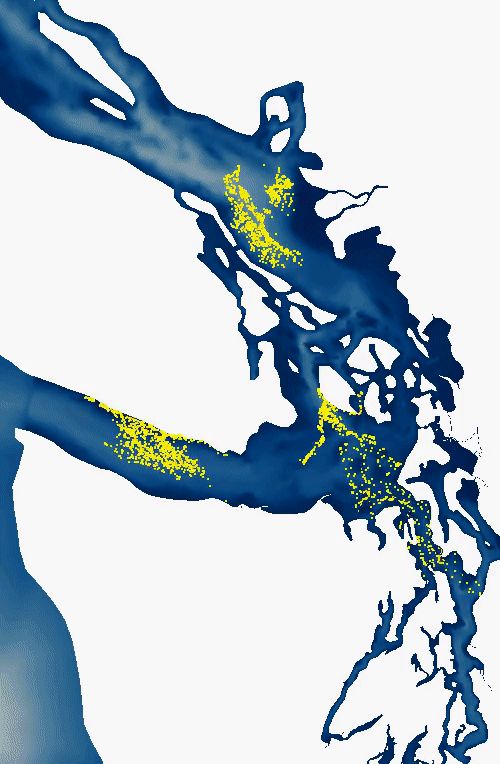
"the mountain and the sea are excellent schoolmasters, and teach some of us more than we can ever learn from books." -john lubbock
Meet Our Team
The Salish Sea School is committed to cultivating and preserving a culture of diversity, inclusion, and connectedness. We are able to grow and learn better together with a diverse team. We welcome the unique contributions that one can bring in terms of their education, opinions, culture, ethnicity, race, sex, gender identity and expression, nation of origin, age, languages spoken, veteran’s status, color, religion, disability, sexual orientation and beliefs.
We are stronger together with the collective sum of individual differences, life experiences, knowledge, innovation, self-expression, and talent which ultimately brings about a healthier planet.
Click on the pictures below to learn more.

Adventure: Baleen Whales of the Salish Sea
Learn about the baleen whales (humpbacks, grays, & minkes) of the Salish Sea
Research: Marine Debris Survey
Guardians will conduct a marine debris survey to collect, analyze, and record marine debris local beaches. All data collected will be recorded as a long-term data set to help local scientists and researchers in the area to better evaluate the overall health of the Salish Sea.
Action: Marine Debris Reduction
Students will participate in a beach clean-up and brainstorm ways to reduce marine debris.
WHAT IS MARINE DEBRIS?
In the United States, marine debris is defined as “any persistent solid material that is manufactured or processed, directly or indirectly, intentionally or unintentionally, disposed of or abandoned into the marine environment or the Great Lakes.”
Marine debris is a growing global problem that harms the environment and commerce, as well as threatens navigation safety and human health. Source: WA Marine Debris Action Plan
Alternatives to single-use plastics:
Plastic bags
Tooth brushes
Water bottles
WHAT ARE MICROPLASTICS?
"You could be swallowing a credit card's weight in plastic every week."
A new analysis titled Assessing Plastic Ingestion from Nature to People was produced by Dalberg and the University of Newcastle Australia for the WWF. An excerpt states: "The largest source of plastic ingestion is drinking water* with plastic found in water (groundwater, surface water, tap water and bottled water) all over the world17. All samples were found to contain plastic in a study on bottled water, which used a limited sample of locations around the world18. As shown figure 3, a recent study, suggests large regional variations, with twice as much fibres per 500ml observed in American or Indian water as in European or Indonesian tap water19. Another key source is shellfish, accounting for as much as 0.5 grams a week. This comes from the fact that shellfish are eaten whole, including their digestive system, after a life in plastic polluted seas."
Your Plastic Diet - WWF Campaign
"Plastic is polluting the air we breathe, the water we drink and the food we eat."
Plastics contamination in the marine environment was first reported nearly 50 years ago, less than two decades after the rise of commercial plastics production, when less than 50 million metric tons were produced per year.
In 2014, global plastics production surpassed 300 million metric tons per year. Plastic debris has been detected worldwide in all major marine habitats, in sizes from microns to meters. In response, concerns about risks to marine wildlife upon exposure to the varied forms of plastic debris have increased, stimulating new research into the extent and consequences of plastics contamination in the marine environment (source article).
The same study continues "Some types of plastic carry chemicals and additives with potential effects on human health. Identified health risks are due to production process residues, additives, dyes and pigments found in plastic25, some of which have been shown to have an influence on sexual function, fertility and increased occurrence of mutations and cancers26,27. Airborne microplastics may also carry pollutants from the surrounding environment. In urban environments, they may carry PAHs – molecules found in coal and tar − and metals28.
Studies are underway to better understand the effects of plastic on our health. A key challenge to research is the overwhelming presence of plastic in our daily life, making it very hard to isolate the effect of a specific exposure pathway from other possible causes of exposure."
The Pacific Northwest National Laboratory developed the Salish Sea Model (SSM) for coastal estuarine research, restoration planning, water-quality management, and climate change response assessment. "In addition to assessments of impacts from watershed runoff and wastewater discharges, the SSM is currently being utilized for the analysis of Salish Sea response to sea level rise, climate change, and propagation of global ocean acidification into the inner estuarine environment." Here you can see the Sediment Transport Modeling within the Salish Sea Modeling framework.

